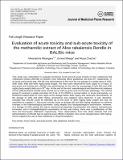Evaluation of acute toxicity and sub-acute toxicity of the methanolic extract of Aloe rabaiensis Rendle in BALB/c mice

View/
Date
2019-07-10Author
Mkangara, Mwanaisha
Mbega, Ernest
Chacha, Musa
Metadata
Show full item recordAbstract
This study was undertaken to evaluate preclinical acute and sub-acute toxicity of Aloe rabaiensis leaf methanolic extract (ARLME) on BALB/c mice following OECD guidelines 423 and 407, respectively. In an acute oral toxicity test, ARLME was administered to the mice by oral gavage at a single dose of 1000, 2000, 3000, 4000 and 5000 mg/Kg body weight. The mice were observed for toxic signs for 14 days. In sub-acute oral toxicity test, ARLME was administered to the mice by oral gavage at 500, 800 and 1000 mg/Kg body weight daily up to 28th day. At the end of the test, haematological and biochemical analyses of the collected blood sample were carried out as well as gross and microscopic pathology. The control group (F) received a single oral dose of 0.5 mL of 1% DMSO in normal saline. In acute oral toxicity, no treatment-related death or toxic signs at the dosage below 4000 mg/Kg was observed. Nevertheless, at the dosage of 4000 and 5000 mg/Kg, drowsiness and sedation were observed. It was, therefore, revealed that ARLME could be tolerated up to the dose of 3000 mg/Kg body weight and may be classified as category 5. Sub-acute toxicity study at dosage 500 and 800 mg/Kg displayed no adverse changes in the haematological parameter, body weights and histopathological examination. However, at a dosage of 1000 mg/Kg, the serum biochemical aspartate transaminase and alanine transaminase increased, and in histopathological examination of liver and kidney, there was a proliferation of bile duct and leucocytes infiltration respectively. Thus, observations from this study indicate that oral administration of ARLME had no adverse toxic effects in BALB/c mice at the dosage below 1000 mg/Kg, hence supports the use of Aloe rabaiensis in drug formulations.
